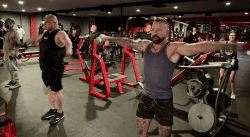How Weight Training Improves A Runner’s Body
When you think about a runner, what comes to mind? An athlete who runs, right? That their training regimen is quite simple and straightforward – they run and only run! WRONG! To build a runner’s body to optimum condition, they need to add more to their training regimen than just running. In fact, weight training is an integral component to a runner’s training, especially for distance runners.
Let’s take a step back first and explain the three basic types of weight training; namely, circuit training, weight lifting, and explosive weight lifting. Circuit training by definition involves high intensity short exercises with little or to no rest in between the exercises. As many of the students at PG know, this can consist of five or ten different exercises, each done with at a prescribed amount of repetitions. Weight lifting is simple to define, moving weights in slow and controlled movements at varying levels of weight. Explosive training is fast lifting such as a clean-and-jerk lift which involves an explosion of one’s body into a prescribed position while carrying an assigned weight or bar.
Each of these types of weight training, all of which are administered during the various classes offered here at PG, assist and advance a runner’s race time as well as facilitate the reduction of their potential injury. Follow my logic:
(1) Circuit training benefits the cardiovascular system as there is little to no rest between exercises, it requires the athlete to keep their heart rate at an elevated level for an extended period of time. The development of an athlete’s cardiovascular system increases the runner’s endurance and ability to maintain a higher heart rate for an extended period of time.
(2) Weight lifting benefits in the development, growth and pure strengthening of an athlete’s muscles view private instagram 2017 in the assigned area of the body where the resistance is being placed. For example, lunges with 15lbs dumbbells works the athlete’s hamstrings and glutes. The continued advancement of this exercise will inevitably lead to the use of 20lb+ dumbbells displaying the simple fact that those particular muscles are getting stronger. As any runner knows, the hamstrings and glutes are vital muscles in the uphill climb on a long run.
(3) Explosive training increases the athlete’s ability to coordinate muscle actions at a fast rate of speed. Additionally, explosive training increases muscle fiber recruitment. By simply increasing the number of fibers used during an exercise, athletes can increase their weight and hit more muscle fibers which inevitably leads to greater changes in growth and development of those areas. This translates to runners by increasing their muscle fibers response allowing them to sprint at a faster rate of speed.
As you can clearly see, weight training, in its various forms, assists a runner with decreasing their rate of speed during sprints and endurance runs. Many runners, including the author of this article, used to believe the gross misconception that lifting weights will make them bigger. This runner’s nightmare given that in theory, the smaller you are, the faster you run. Take it from us, weight lifting does NOT make you bigger. On the contrary it makes you leaner and faster. Don’t believe us? Stop into PG today and speak with one of our experienced fitness instructors and try out one of our many classes to see what we mean. You will NOT be disappointed you did.




